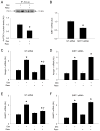Resveratrol prevents dexamethasone-induced expression of the muscle atrophy-related ubiquitin ligases atrogin-1 and MuRF1 in cultured myotubes through a SIRT1-dependent mechanism
- PMID: 22166204
- PMCID: PMC3261799
- DOI: 10.1016/j.bbrc.2011.11.154
Resveratrol prevents dexamethasone-induced expression of the muscle atrophy-related ubiquitin ligases atrogin-1 and MuRF1 in cultured myotubes through a SIRT1-dependent mechanism
Abstract
Resveratrol (3,5,4'-trihydroxystilbene) has been ascribed multiple beneficial biological effects but the influence of resveratrol on glucocorticoid-induced muscle atrophy is not known. We examined the effects of resveratrol on dexamethasone-induced atrogin-1 and MuRF1 expression, FOXO1 acetylation, protein degradation and atrophy in cultured L6 myotubes. In addition, the role of the deacetylase SIRT1 in the effects of resveratrol was determined by transfecting myotubes with SIRT1 siRNA. The catabolic effects of dexamethasone were prevented by resveratrol and the protective effects of resveratrol on dexamethasone-induced atrogin-1 and MuRF1 expression were abolished in myotubes transfected with SIRT1 siRNA. Results suggest that resveratrol can prevent glucocorticoid-induced muscle wasting and that this effect is at least in part SIRT1-dependent.
Copyright © 2011 Elsevier Inc. All rights reserved.
Figures




Similar articles
-
Suppression of atrogin-1 and MuRF1 prevents dexamethasone-induced atrophy of cultured myotubes.Metabolism. 2013 Oct;62(10):1495-502. doi: 10.1016/j.metabol.2013.05.018. Epub 2013 Jul 15. Metabolism. 2013. PMID: 23866982
-
IGF-I stimulates muscle growth by suppressing protein breakdown and expression of atrophy-related ubiquitin ligases, atrogin-1 and MuRF1.Am J Physiol Endocrinol Metab. 2004 Oct;287(4):E591-601. doi: 10.1152/ajpendo.00073.2004. Epub 2004 Apr 20. Am J Physiol Endocrinol Metab. 2004. PMID: 15100091
-
C/EBPβ regulates dexamethasone-induced muscle cell atrophy and expression of atrogin-1 and MuRF1.J Cell Biochem. 2011 Jul;112(7):1737-48. doi: 10.1002/jcb.23093. J Cell Biochem. 2011. PMID: 21381078 Free PMC article.
-
Isoflavones derived from soy beans prevent MuRF1-mediated muscle atrophy in C2C12 myotubes through SIRT1 activation.J Nutr Sci Vitaminol (Tokyo). 2013;59(4):317-24. doi: 10.3177/jnsv.59.317. J Nutr Sci Vitaminol (Tokyo). 2013. PMID: 24064732
-
PPARβ/δ regulates glucocorticoid- and sepsis-induced FOXO1 activation and muscle wasting.PLoS One. 2013;8(3):e59726. doi: 10.1371/journal.pone.0059726. Epub 2013 Mar 21. PLoS One. 2013. PMID: 23555761 Free PMC article.
Cited by
-
Effect of Quercetin on Dexamethasone-Induced C2C12 Skeletal Muscle Cell Injury.Molecules. 2020 Jul 17;25(14):3267. doi: 10.3390/molecules25143267. Molecules. 2020. PMID: 32709024 Free PMC article.
-
Grape Polyphenols in the Treatment of Human Skeletal Muscle Damage Due to Inflammation and Oxidative Stress during Obesity and Aging: Early Outcomes and Promises.Molecules. 2022 Oct 5;27(19):6594. doi: 10.3390/molecules27196594. Molecules. 2022. PMID: 36235130 Free PMC article. Review.
-
Resveratrol attenuates denervation-induced muscle atrophy due to the blockade of atrogin-1 and p62 accumulation.Int J Med Sci. 2018 Apr 3;15(6):628-637. doi: 10.7150/ijms.22723. eCollection 2018. Int J Med Sci. 2018. PMID: 29725254 Free PMC article.
-
Resveratrol promotes myogenesis and hypertrophy in murine myoblasts.J Transl Med. 2013 Dec 13;11:310. doi: 10.1186/1479-5876-11-310. J Transl Med. 2013. PMID: 24330398 Free PMC article.
-
Polyphenols and Their Effects on Muscle Atrophy and Muscle Health.Molecules. 2021 Aug 12;26(16):4887. doi: 10.3390/molecules26164887. Molecules. 2021. PMID: 34443483 Free PMC article. Review.
References
-
- Soleas GJ, Diamandis EP, Goldberg DM. The world of resveratrol. Adv Exp Med Biol. 2001;492:159–182. - PubMed
-
- Burns J, Yokota T, Ashikara H, Lean ME, Crozier A. Plant foods and herbal sources of resveratrol. J Agric Food Chem. 2002;50:3337–3340. - PubMed
-
- Chen CJ, Yu W, Fu YC, Wang X, Li JL, Wang W. Resveratrol protects cardiomyocytes from hypoxia-induced apoptosis through the SIRT1-FoxO1 pathway. Biochem Biophys Res Commun. 2009;378:389–393. - PubMed
-
- Chen KH, Cheng ML, Jung YH, Chiu DTY, Shiao MS, Chen JK. Resveratrol ameliorates metabolic disorders and muscle wasting in streptozotocin-induced diabetic rats. Am J Physiol Endocrinol Metab. 2011;301:E853–E863. - PubMed
-
- Das S, Khan N, Mukherjee S, Bagchi D, Gurusamy N, Swartz H, Das DK. Redox regulation of resveratrol-mediated switching of death signal into survival signal. Free Rad Biol Med. 2008;44:82–90. - PubMed
Publication types
MeSH terms
Substances
Grants and funding
LinkOut - more resources
Full Text Sources
Other Literature Sources
Research Materials
Miscellaneous

